Carbon Reduction Plan
nGAGE Talent Group
Carbon Reduction Plan (CRP) 2023-24
Publication date: September 2024
nGAGE’s carbon reduction plan is presented in response to Procurement Policy Note (PPN) 06/21. It provides transparency and demonstrates progress towards building a robust carbon reduction
programme.
Commitment to achieving Net Zero
nGAGE Talent is comprised of a group of brands within the talent management sector. These brands are Holt Doctors, Agile Workforce, LMS, Butler Rose, Cloud4 Solutions, Attenti, Caritas, Bridge of Hope, Eden Brown Synergy, Cloud MR, Proactive, Tien Select, Ryalto, EWI, GCS, Retinue, RX, Eden Brown Built Environment and RG Set Square.
nGAGE Talent and it associated brands aim to achieve net-zero Scope 1, 2 and 3 emissions by 2050 from a FY 23/24 base year.
nGAGE has changed its base year from FY 22/23 to FY 23/24, as more comprehensive data was available for the latter year. This has allowed the business to get a better understanding of its company-wide footprint and provides a more realistic baseline for business emissions.
To achieve net-zero, nGAGE is aiming for at least a 90% reduction in absolute emissions by 2050 compared to its FY 23/24 base year – any residual emissions will be offset with carbon sequestration offsets, as per the Science-Based Targets initiative’s (SBTi) Net-Zero Standard guidance.
By 2026, nGAGE plans to submit its targets for validation by the Science-Based Target initiative.
On the journey to net zero, nGAGE commits to developing science-aligned near-term targets. nGAGE will work with third-party ESG specialists to create near-term targets for Scope 1, 2 and 3, which will help drive continuous progress towards net-zero.
nGAGE is committed to reducing its impact on the environment, as demonstrated by its ISO 14001 certification for UK operations. This certification, obtained for the first time two years ago, reflects the business’s robust environmental management. nGAGE will continue to adhere to these high standards to minimise its environmental impact and ensure its processes are compliant with recognised best practices.
nGAGE will review and update its Carbon Reduction Plan on an annual basis and within six months of financial year-end, in line with government guidance1. Due to the review cycle, there may be unique instances where the reporting period in our published plan is temporarily older than 12 months the date of commencement of procurement. This will be rectified as soon as the new plan is published. Updates can be requested in writing from nGAGE Group.
This Carbon Reduction Plan, including its targets and energy management measures, applies to nGAGE and all its brands, and the measures detailed in this plan will be in effect when performing any awarded contracts, as per the guidance and technical standards.
Baseline Emissions Footprint
nGAGE has changed its base year from FY 22/23 to FY 23/24, as more comprehensive data was available for the latter year. This has allowed the business to get a better understanding of its company-wide footprint and provides a more realistic baseline for business emissions. Therefore our baseline and current year emissions reporting is the same.
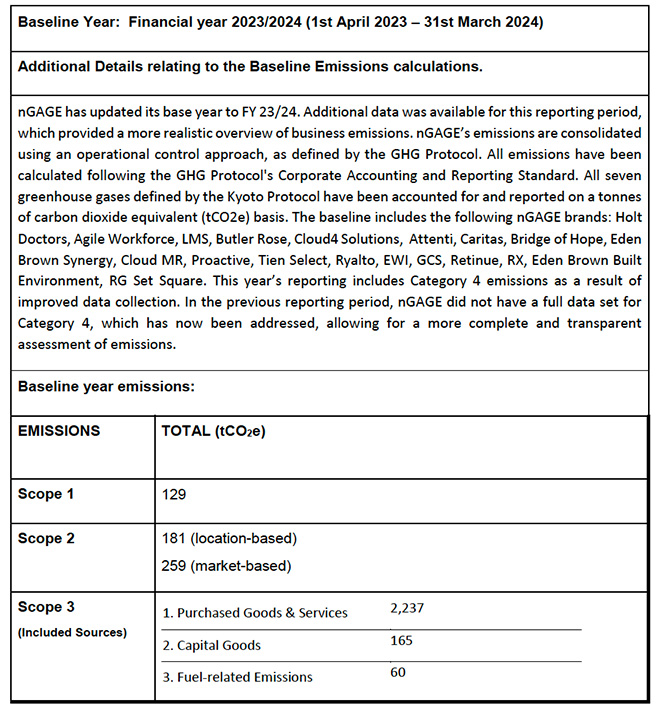
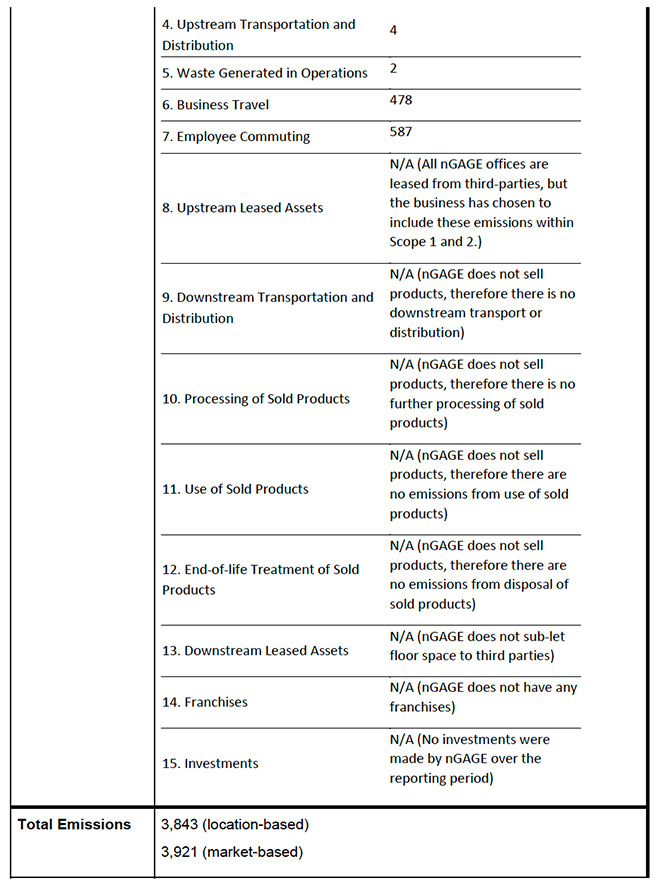
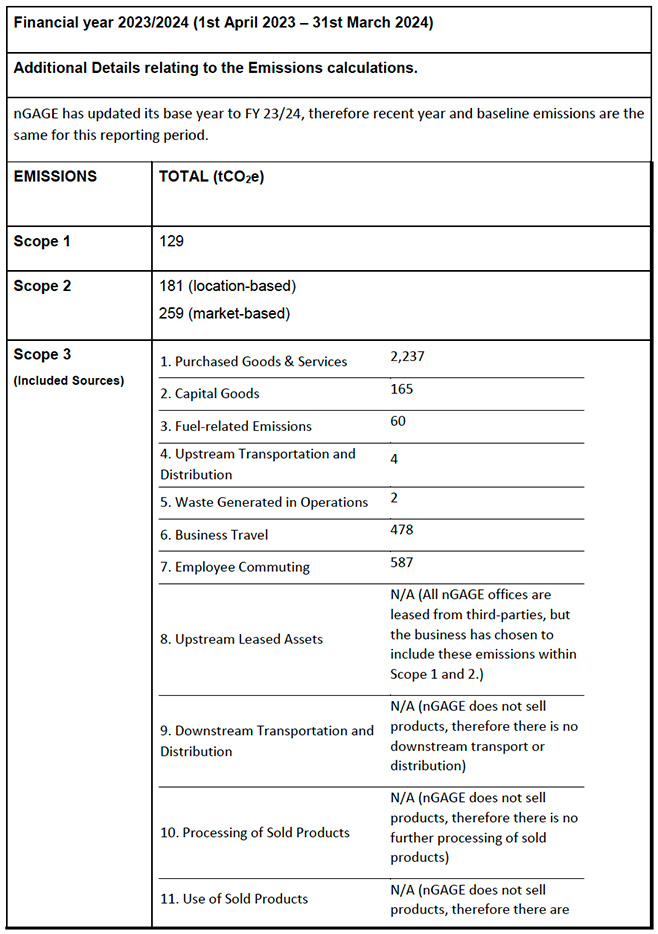
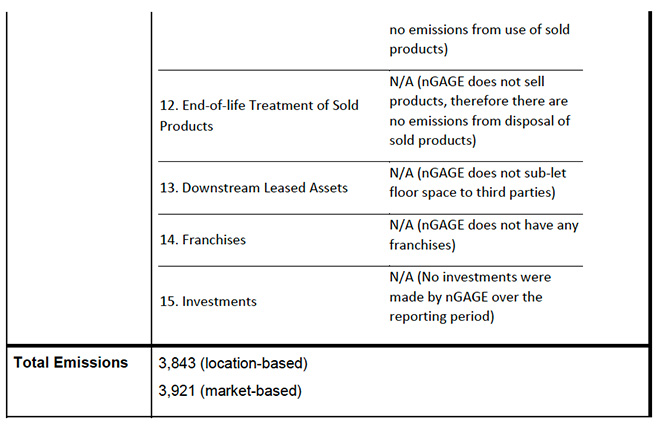
Emissions reduction targets
nGAGE and its associated brands are committed to achieving net-zero Scope 1, 2 and 3 emissions by 2050, in line with the UK Government target. This ambition also aligns with the SBTi recommendations for businesses to reach net-zero by 2050, in order to limit global warming to 1.5°C.
nGAGE is currently working with third party ESG specialists to develop near-term targets for Scope 1, 2 and 3, in accordance with the SBTi Corporate Near-Term Criteria. These near-term targets will provide a goal for decarbonisation over the next 5-10 years and will help drive progress towards nGAGE’s longer-term net-zero target.
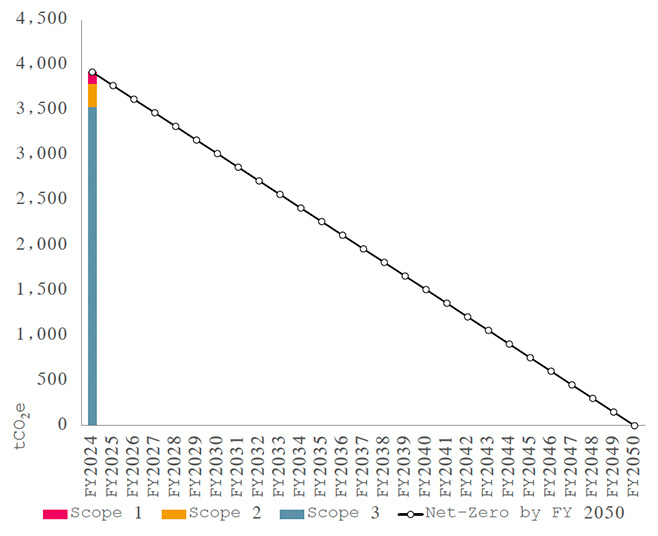
Carbon Reduction Projects
Completed Carbon Reduction Initiatives
The following environmental management measures and projects have been completed or implemented.
Hybrid Working
nGAGE has a hybrid working policy that allows employees to work remotely. The policy provides staff with more flexibility during the working week and minimises the requirement for them to travel into the office. As a result, hybrid working reduces emissions from both staff commuting and energy consumption in the offices.
Cycle-to-Work Scheme
nGAGE provides a cycle-to-work scheme for employees, which encourages employees to purchase commuter bikes and cycling accessories through their employer. The scheme works as a salary sacrifice benefit so employees can make tax and National Insurance savings on the cost of new bikes. It also enables employees to spread the cost of their purchases over 12 months to reduce the upfront cost. By encouraging employees to buy bikes for commuting, nGAGE can reduce its employee commuting footprint.
Mains Gas
Mains gas emissions can be reduced or avoided altogether through alternative heating sources. As all nGAGE’s offices are leased sites, it is not within the company’s direct control to make such infrastructure changes. However, nGAGE has been applying pressure to its property providers to move to alternative heating sources and, should that not be successful, will consider moving to more energy efficient sites.
Reduction in Office Space
The Reading office was downsized during the FY23/24 reporting period, which has meant that nGAGE now only occupy around 40% of the floor space, compared to the previous reporting year. Additionally, in Scotland, nGAGE closed one of the Glasgow offices and relocated from one Edinburgh site to another. The previous Austin Friars site in London is also now no longer in use. This has contributed to reduced gas and electricity consumption, and associated emissions.
Further Carbon Reduction Opportunities
In the future we hope to implement further measures such as:
Hybrid Working
nGAGE will continue to provide a hybrid working model for employees to reduce the impact of
employee travel and office work.
Sustainable Travel Policy
By implementing a Sustainable Travel Policy, nGAGE hopes to influence employees’ behaviour around
travel and encourage use of low emissions transport modes.
Improving Emissions Data
nGAGE has contracted third-party ESG specialists to calculate a full Scope 1, 2 & 3 global emissions
inventory, to increase the granularity of data and better understand emissions hotspots. This will help
nGAGE to target relevant emissions reduction initiatives in future.
Net-Zero Strategy Development & SBTis
nGAGE will be working with their third-party ESG specialists to develop near-term targets and a netzero
strategy, to strengthen its 2050 net-zero commitment and facilitate its goal of having SBTi
validated targets.
ESOS Phase 4
Following nGAGE’s ESOS Phase 3 notification submission, the business needs to submit an ESOS Action Plan by 5th December 2024 and provide progress updates against these actions in the two subsequent years. A key focus of FY 24/25 will be developing and submitting nGAGE’s plan to reduce energy consumption.
CycleSave Bike Scheme
nGAGE plans to roll out the CycleSaver bike scheme, a cycle-to-work scheme that focuses on bike hire subscriptions rather than bike purchases. Similar to the bike purchase schemes, the cost of bike subscriptions gets deducted pre-tax.
Landlord Engagement
nGAGE plans to further engage with landlords on leased and managed offices, where possible, to understand current renewable energy usage and de-gasification plans, as well as energy efficiency measures.
Hiring Locally
nGAGE will continue to hire talent locally, where possible, to reduce commuting emissions for employees.
These reduction strategies apply across the group and are adopted by all of our brand companies during the performance of their contracts.
Declaration and Sign Off
This Carbon Reduction Plan has been completed in accordance with PPN 06/21 and associated guidance and reporting standard for Carbon Reduction Plans.
Emissions have been reported and recorded in accordance with the published reporting standard for Carbon Reduction Plans and the GHG Reporting Protocol corporate standard2 and uses the appropriate Government emission conversion factors for greenhouse gas company reporting.
Scope 1 and Scope 2 emissions have been reported in accordance with SECR requirements, and Scope 3 emissions have been reported in accordance with the published reporting standard for Carbon Reduction Plans and the Corporate Value Chain (Scope 3) Standard3.
This Carbon Reduction Plan has been reviewed and signed off by the SMT of nGAGE Talent group (directors).
Signed on behalf of nGAGE Talent:

……………………………
Adam Herron, Group COO
Date: 23rd September 2024
Appendix A Reporting Methodology
Scope 1 and 2 greenhouse gas emissions have been calculated according to the 2019 UK Government environmental reporting guidance. Consistent with the guidance, relevant emissions factors published in the UK Government’s Department for Business, Energy and Industrial Strategy (BEIS) “Greenhouse gas reporting: conversion factors” database-specific reporting year have been used for UK sites. Where possible, country-specific conversion factors have been used for global operations. The CO2 equivalent conversion factor has been used throughout, and, where applicable, the kWh gross calorific value (CV) was used.
Scope 1 and 2 emissions have been calculated using both a location-based and market-based approach:
Location-Based: This method calculates emissions associated with fuel and electricity consumption by using UK average emissions intensities. BEIS provides UK emissions factors for fuel and grid electricity annually, which are used in location-based reporting. For global sites, emissions factors are taken from the International Electricity Factors database provided by Carbon Footprint Ltd.
Market-Based: This method calculates emissions associated with fuel and electricity consumption by using contract-specific emissions intensities. Market-based reporting enables companies that purchase lower carbon fuel and electricity to demonstrate the benefit of their investment.
Transport-related emissions from fuel combustion were calculated using the BEIS “Greenhouse gas reporting: conversion factors” database. Country-specific factors were not available for transport, so the UK factors were used for all countries.
Scope 3 emissions have been calculated based on the guidance in the Greenhouse Gas Protocol “Corporate Value Chain (Scope 3) Standard”.
For all operations, applicable Scope 3 categories were identified based on an operational control boundary. Scope 3 emissions for applicable categories were calculated following methodologies outlined in the GHG Protocol "Technical Guidance for Calculating Scope 3 Emissions", with further guidance taken from the GHG Protocol's detailed methodology chapters for each applicable Scope 3 category.
Most conversion factors were sourced from the BEIS Greenhouse gas reporting: conversion factors, v1.0 2023 database. Where a spend-based approach was used, as per the GHG Protocol guidance, conversion factors were taken from the University of Leeds and the Department for Environment, Food and Rural Affairs' UK Footprint Results (1990 – 2018)' study or the Department for Environment, Food and Rural Affairs' Indirect emissions for the supply chain' database. Scope 3 emissions include Well to Tank and T&D losses.

